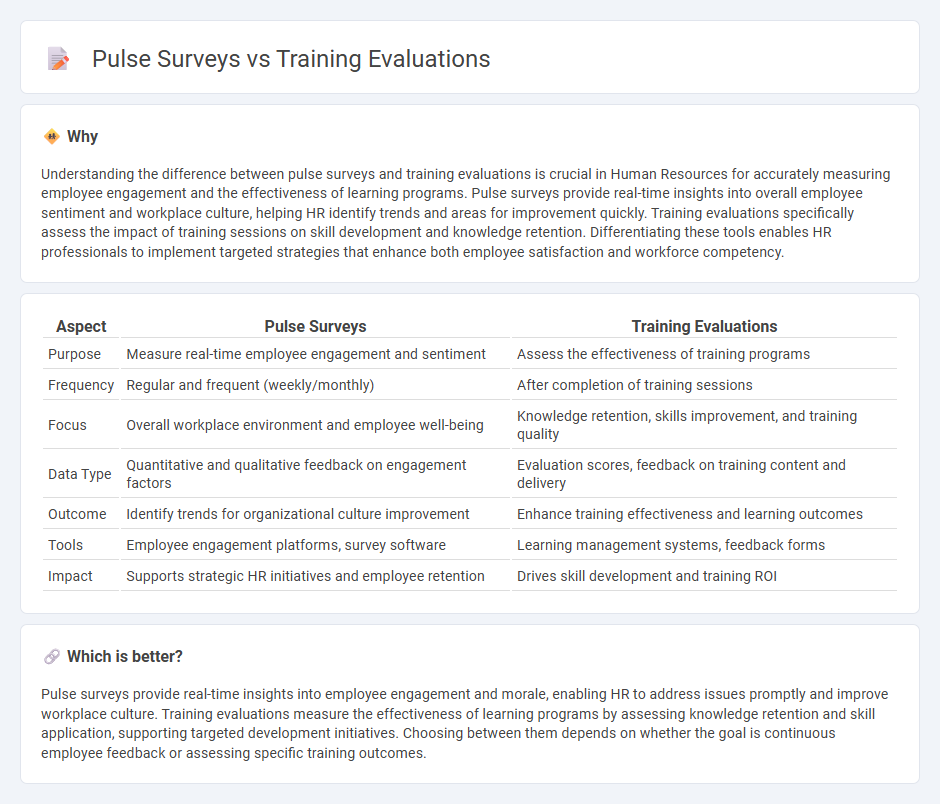
Pulse surveys provide real-time insights into employee engagement and workplace sentiment through short, frequent questionnaires, enabling HR teams to respond swiftly to workforce needs. Training evaluations measure the effectiveness and impact of learning programs by collecting feedback on content, delivery, and outcomes, helping to enhance future training initiatives. Explore how integrating pulse surveys with training evaluations can optimize talent management strategies and improve organizational performance.
Why it is important
Understanding the difference between pulse surveys and training evaluations is crucial in Human Resources for accurately measuring employee engagement and the effectiveness of learning programs. Pulse surveys provide real-time insights into overall employee sentiment and workplace culture, helping HR identify trends and areas for improvement quickly. Training evaluations specifically assess the impact of training sessions on skill development and knowledge retention. Differentiating these tools enables HR professionals to implement targeted strategies that enhance both employee satisfaction and workforce competency.
Comparison Table
| Aspect | Pulse Surveys | Training Evaluations |
|---|---|---|
| Purpose | Measure real-time employee engagement and sentiment | Assess the effectiveness of training programs |
| Frequency | Regular and frequent (weekly/monthly) | After completion of training sessions |
| Focus | Overall workplace environment and employee well-being | Knowledge retention, skills improvement, and training quality |
| Data Type | Quantitative and qualitative feedback on engagement factors | Evaluation scores, feedback on training content and delivery |
| Outcome | Identify trends for organizational culture improvement | Enhance training effectiveness and learning outcomes |
| Tools | Employee engagement platforms, survey software | Learning management systems, feedback forms |
| Impact | Supports strategic HR initiatives and employee retention | Drives skill development and training ROI |
Which is better?
Pulse surveys provide real-time insights into employee engagement and morale, enabling HR to address issues promptly and improve workplace culture. Training evaluations measure the effectiveness of learning programs by assessing knowledge retention and skill application, supporting targeted development initiatives. Choosing between them depends on whether the goal is continuous employee feedback or assessing specific training outcomes.
Connection
Pulse surveys provide real-time insights into employee engagement and satisfaction, which help identify training needs and areas for improvement. Training evaluations measure the effectiveness of learning programs, offering data that can be compared with pulse survey results to assess the impact on workforce performance. Integrating these tools enhances talent development strategies and drives continuous improvement in human resource management.
Key Terms
**Training Evaluations:**
Training evaluations provide comprehensive feedback on program effectiveness, focusing on knowledge retention, skill improvement, and learner satisfaction immediately after course completion. They capture detailed insights through structured questionnaires, allowing organizations to measure training impact against specific learning objectives. Explore how robust training evaluations can enhance your workforce development strategy.
Learning Outcomes
Training evaluations provide detailed insights into participants' learning progress, skill acquisition, and knowledge retention following a structured educational program, often using quizzes and practical assessments. Pulse surveys capture real-time feedback on learners' experiences, engagement levels, and immediate reactions, enabling quick adjustments to training delivery. Explore deeper to understand how each method enhances learning outcomes and supports continuous improvement.
Feedback Forms
Training evaluations provide comprehensive feedback on specific learning sessions, capturing detailed insights on content effectiveness, instructor performance, and learner satisfaction. Pulse surveys, by contrast, offer rapid, frequent snapshots of employee engagement and sentiment, enabling continuous monitoring and quick responsiveness. Explore how leveraging both tools can enhance organizational feedback strategies and drive targeted improvements.
Source and External Links
How to Conduct a Training Evaluation - A guide to evaluating training programs through assessing each stage of the process and setting key performance indicators.
Training Evaluation: 5 Methods for Assessing Training Programs - Provides structured methods to assess training effectiveness, focusing on knowledge acquisition, participation, and application.
6 Best Training Evaluation Models - Offers insights into frameworks like the Kirkpatrick Model for evaluating training effectiveness and aligning with business objectives.
 dowidth.com
dowidth.com